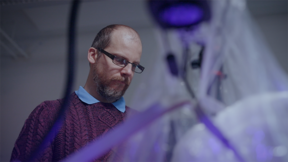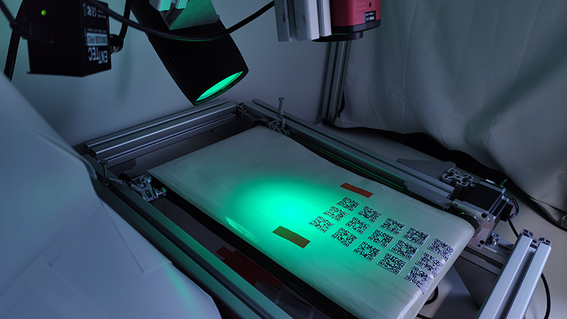Juha Koivisto wins Innovation Prize at Department of Applied Physics


Academy Postdoctoral Researcher Juha Koivisto has been awarded the first Innovation Prize of the Department of Applied Physics in Aalto University for inventing a method to detect dirt on surfaces with hyperspectral imaging. The invention has led to founding CleanDet Ltd. after a successful Research to Business project funded by Business Finland.
The roots of the invention go back to combining technical know-how with an entrepreneurial mindset. Koivisto has been doing research on imaging and image analysis for 15 years and has also developed programming, mechanics and electronics skills through his car and computer hobbies.
In 2015 Koivisto participated with his friend Pasi Karppinen in a hackathon organised by Lassila & Tikanoja with a proposal to guide cleaning with the help of security cameras. Lassila & Tikanoja's representatives welcomed the idea – the team’s expertise could be used to solve a problem that was important to the company: how to detect when surfaces get dirty and need cleaning. Koivisto and Karppinen took up this challenge and figured out that hyperspectral imaging could solve the problem. "Suddenly, our project was no longer about security cameras, but about hyperspectral cameras," Koivisto says.
The idea seemed promising and the team received Business Finland's Research to Business funding for its development and commercialisation. KiiltoClean and Senaatti-Kiinteistöt joined the project as business partners, and Karppinen became the project’s commercialisation expert. In addition, the team involved postdoctoral researchers and research assistants to build a working prototype and evaluate its commercial potential. The project was successful and led to founding CleanDet.
Extensive application possibilities
The potential impact of the invention is great due to its many possible applications. "Our technology is going to change how we think about cleanliness and cleaning of surfaces. The thinking will change from scheduled cleaning to cleaning as needed – cleaning based on data. The data collected by imaging can tell you, for example, what kind of cleaning chemical is required to clean a particular surface.
One of the most interesting applications is the use in hospitals. "It has come as a surprise to us that the cleanliness of surfaces is still visually assessed in some hospitals. With a hyperspectral camera, it would be possible to monitor the cleanliness of the space or a device continuously and automatically receive a notification when it gets dirty. The camera can also be used to ensure the quality of prewashing medical instruments before their sterilization," says Koivisto.
"At the moment, we have shown that our devices are able to detect fingerprints on the surface of tables. Our method is as accurate as the human eye and more accurate than the commonly used sweep test. We have plans ready for a comparative test to show this in hospital conditions," Koivisto says.
Through automation the same method could be used, for example, in the food industry, and at airports it could provide an early warning system to prevent the spread of infectious diseases.
A suitable problem for artificial intelligence
The invention uses various light sources and artificial intelligence to improve the accuracy of hyperspectral imaging for detecting organic substances on inorganic surfaces. The hyperspectral camera sees more wavelengths of light than a standard camera, thus providing more information about the materials of the object in the image. The light source used in imaging is also important: illuminating the object with different coloured lights makes contamination stand out more clearly from the image. "The advantage of our method is that it does not need UV light that is harmful to humans and weakens many materials. All we need is visible light."
Koivisto says that the need for artificial intelligence comes from the complexity of the problem. "This is a good example of a problem where artificial intelligence can help greatly. Imaging generates a lot of data: a single megapixel hyperspectral image contains 20 million measuring points. This is well suited for artificial intelligence: one part of the image data can be used for training the artificial intelligence, while the other parts are interpreted by it." Teaching AI to detect the dirt signals in the data is easy because there are so many data points. Koivisto illustrates the importance of a large amount of data: "If AI were taught, for example, to identify connections between blood type and disease, one measuring point would correspond to one person. In this sense, one hyperspectral image corresponds to millions of people."
The technology used by CleanDet is old, but the application of artificial intelligence to it is new: "Hyperspectral imaging has been used, for example, in slaughterhouses to monitor the purity of meat. However, our AI solution is unique and ahead of competitors," Koivisto says.
Interest in entrepreneurship
Koivisto has long been interested in entrepreneurship and has been doing small projects for his friend's company since 2007. "I am interested in developing technical solutions to real problems. One good indication that the problem is real and important is that someone is willing to pay for its solution," Koivisto says.
Juha says that Business Finland's funding was important for the founding of CleanDet. His own research was far from practical applications, but thanks to the Research to Business funding, it was possible to direct it towards solving a practical problem with a clear goal: to find a solution to a commercially important problem and to start a business.
The support of the research group and other team members was also important. In addition, Aalto Startup Center coached the team in patenting, developing the business model and understanding the commercialization path from idea to product.
"It is good to bring people with experience in commercialising technology into the team," Koivisto says. It helps if you know entrepreneurs in advance and have even worked with them throughout your research career. They can be your friends or classmates who are now entrepreneurs. Koivisto's network has known about his interest in application-driven research. "Maintaining networks is important so that people know what you are doing and what you are aiming for so that they are ready to give advice or recommend other people if necessary," Koivisto says.
According to Koivisto, you can also do something as a side job that others can take up, and it is good to tell others about these projects. "It doesn't make sense to develop anything in secret," Koivisto says. “Some people think they have to keep everything a secret or else others will steal your ideas. But it's a good idea to tell everyone about it. No one is going to steal your idea because the idea is always very far from practice - there is a huge amount of work." Rather, the problem is the opposite: "It's easy to get advice, but it's hard to get others to work on your idea," laughs Koivisto.
This doesn't mean you should share openly the technical details of the idea, but it's important to tell what is the problem that you're going to solve and what your approach is. Often this is enough for others to be able to help you move forward with your project. "Whenever you make something work, you should tell others what you have solved, but not how," Koivisto says.
On the other hand, you should also be open about problems so that others know how best to help you. By being open, but realistic, you build trust. “It's better to say that now we're here and next we'll solve this problem than to claim that all the problems will be solved at once.” Milestones are agreed with investors or financiers, and more funding is available when you reached them, starting with the easiest.
Coronavirus complicates but is also an opportunity
CleanDet has now one pilot customer and the first deliveries are expected by the end of this year. However, the coronavirus pandemic has slowed down the testing of the method in applications. The current group of end users are in the health sector, and at the moment the whole sector is overstretched by handling the pandemic and therefore lacks time for testing these new devices.
At the same time, CleanDet's technology could help fight the spread of the virus. Although it is not possible to see the coronavirus directly, it is known to spread through droplets and saliva. With CleanDet's method, saliva could be detected on surfaces, which could help keep them clean.
"Our next goal is to design and finish the first complete product offering: equipment, user manual and delivery. In other words, the so-called minimum viable product, i.e. a product that the customer can buy and use independently without needing further instructions from us," Koivisto says.
A model example of developing an idea
Ilkka Hyytiäinen, Innovation Advisor at the School of Science, says that Koivisto's and his team's innovation is a prime example of a commercialisation project: "From the very beginning, the team developed the idea with commercial exploitation in mind, doing the right things along the way, for example by involving companies in refining the team's idea and solution at an early stage".
Although a team has been behind the innovation, Koivisto's role has been central in Aalto. Every invention needs someone who has the desire to bring an idea into the world and work hard for it – someone who can inspire others to join the project. "Juha Koivisto is an excellent example of this. Without such a person, even good ideas will wither," Hyytiäinen says.
Koivisto is developing his company while continuing as a researcher at Aalto University. "Becoming a full-time entrepreneur requires financial visibility for the company further into the future," Koivisto says. "Aalto offers good support for working as a researcher-entrepreneur – the rules for combining the two roles are clear, which is a really good thing," Koivisto says.
Finally, Koivisto gives advice to anyone interested in Hackathons: "It's worth participating in. It's a good way to learn, and you don't lose anything. You can see very quickly that no one was born to commercialise technology. Everyone learns it in practice."
Background to the innovation prize
Aalto University's Department of Applied Physics is known for high-quality scientific research in many fields of physics. However, many companies have also emerged from the department, such as Canatu (carbon nanotubes for cars) IQM (quantum computers), and Bluefors (refrigeration machines for low temperature physics).
The Innovation Prize of the Department of Applied Physics was established in 2020 to reward annually one staff member or team that has actively sought to commercialise the results of their research or to create significant societal benefits in other ways.
Its intention is to particularly acknowledge innovations made by early stage researchers and students who act as examples, thereby encouraging others to further increase the societal impact of the department's research.
Contact
Juha Koivisto
- Published:
- Updated:
Read more news

Get to know us: Associate Professor Maria Sammalkorpi
Sammalkorpi received her doctorate from Helsinki University of Technology 2004. After her defence, she has worked as a researcher at the Universities of Princeton, Yale and Aalto.
Aalto computer scientists in ICML 2024
Computer scientists in ICML 2024
Getting bacteria into line
Physicists use magnetic fields to manipulate bacterial behaviour